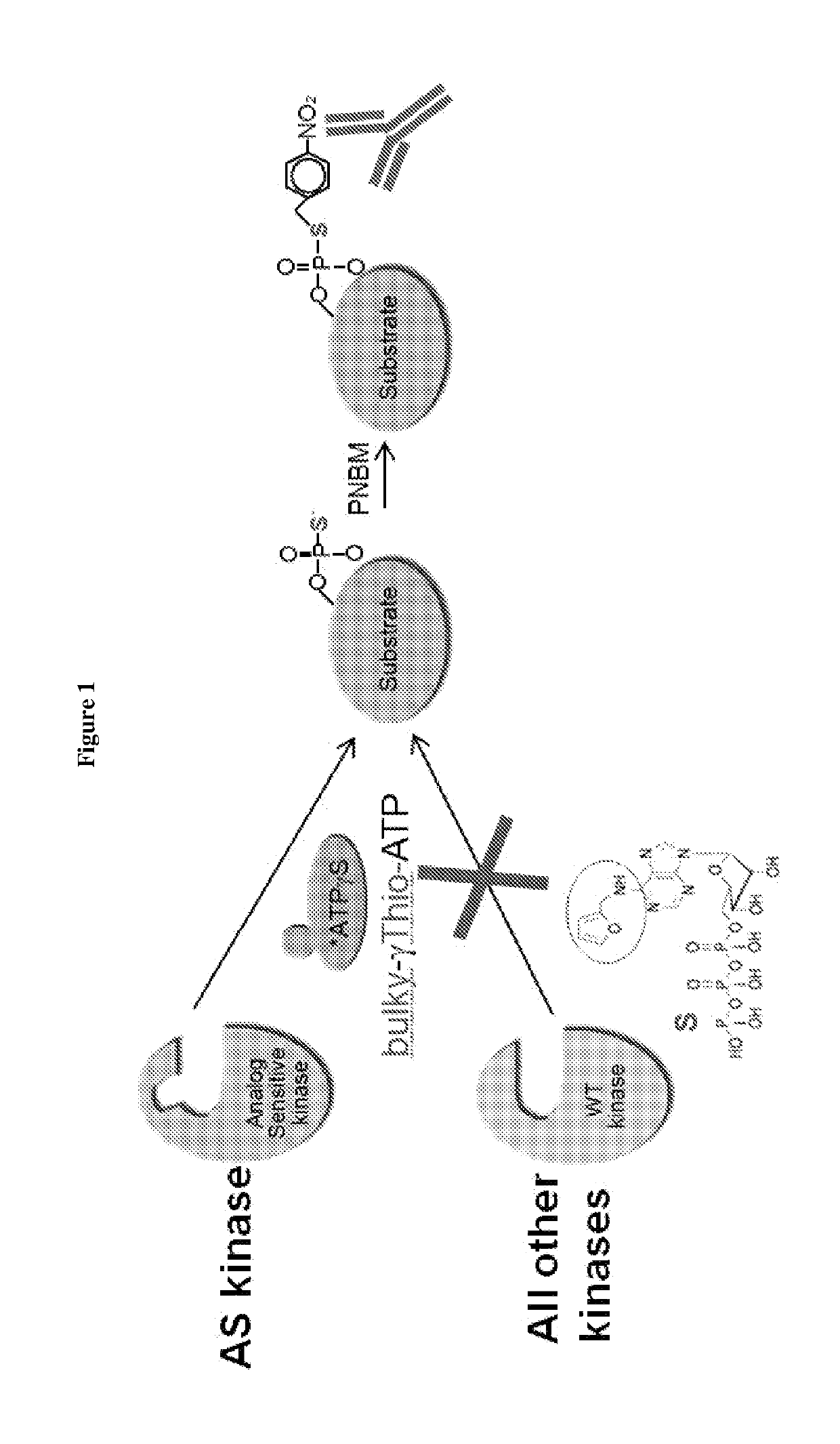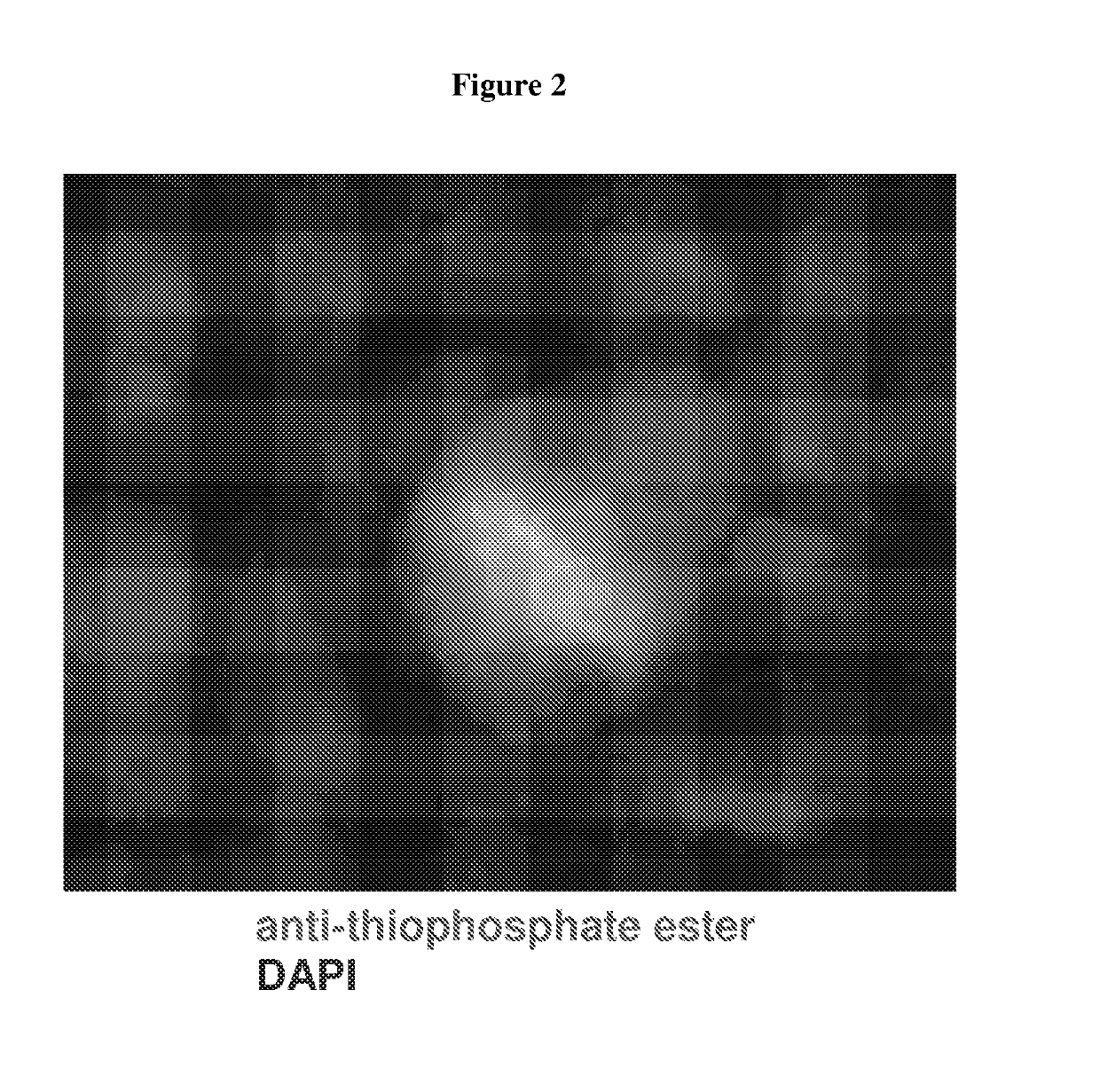In situ visualization of kinase activity
a kinase activity and visualization technology, applied in the field of in situ visualization of kinase activity, can solve the problems of cellular and intracellular architecture disruption, limited detection of phosphorylated proteins, and requiring membrane permeabilization steps
- Summary
- Abstract
- Description
- Claims
- Application Information
AI Technical Summary
Benefits of technology
Problems solved by technology
Method used
Image
Examples
example 1
of Substrates of a Kinase of Interest by Generating an Analog-Sensitive (AS) Mutation in the Kinase
[0096]This example describes a method for detecting substrates of a kinase of interest. As shown in FIG. 1, the ATP-binding pocket of a kinase of interest was modified by a single amino acid substitution to generate an analog-sensitive (AS) enzyme which can accommodate a “bulky” analog of ATP. These analogs cannot be utilized by wild-type kinases. The bulky ATP was additionally modified to contain sulfur in the gamma phosphate, thereby being denoted “bulky-γ-Thio-ATP.” Cells or organisms e.g. mice were engineered to express the AS version of the kinase of interest. The AS kinase used bulky-γ-Thio-ATP and incorporated thiophosphate moieties into its protein substrates. These thiophosphate groups were next alkylated with p-Nitrobenzyl mesylate (PNBM) to create a semisynthetic epitope for an anti-thiophosphate ester antibody for detecting the substrates.
[0097]This method, modified from Sh...
example 2
of Cells in an In Vitro Culture for In Situ Visualization of Kinase Substrates
[0098]This example describes a method of fixing cells in an in vitro culture and visualizing substrates of an AS kinase in the cells, which resolved the problem in Example 1.
[0099]Murine CDK1 was engineered to comprise an AS mutation comprising M32V and F80G substitutions and this mutant CDK1 was substituted for the wild-type CDK1 in both alleles in murine embryonic stem cells. The sequence of the mutant CDK1 is shown in SEQ ID NO: 1, and other mutant CDK1 proteins comprising SEQ ID NOs: 2-4 are expected to function similarly Wild-type or AS mutant murine embryonic stem cells were cultured on glass coverslips and processed according to the steps in FIG. 5. The cells were fixed with 4% formaldehyde at room temperature for 5 minutes. The endogenous thiols were quenched with 20 mM iodoacetamide at 4° C. for 30 minutes. The cells were incubated with 100 μM furfuryladenosine-5′-O-(3-thiotriphosphate) in the pre...
example 3
of Brain Tissues for In Situ Visualization of Kinase Substrates
[0104]This example describes a method of fixing a tissue or an organ and visualizing substrates of an AS kinase in the tissue or organ, which resolved the problem in Example 1.
[0105]Murine CDK5 was engineered to comprise an AS mutation (F80G) and this mutant CDK5 was substituted for the wild-type CDK5 in both alleles in mice. The sequence of the mutant CDK5 is shown in SEQ ID NO: 9, and another mutant CDK1 protein comprising SEQ ID NO: 10 is expected to function similarly. Freshly harvested brains from adult wild-type or mutant mice were frozen and cut into 20 μm sections. The sections were mounted on glass coverslips and fixed with 4% formaldehyde for 5 minutes. The sections were then incubated with 100 μM furfuryladenosine-5′-O-(3-thiotriphosphate) in the presence of 0.1% Triton X-100 for 20 minutes, thereby allowing thiophosphorylation of substrates of the AS kinase. Thiophosphorylated substrates were alkylated with P...
PUM
 Login to View More
Login to View More Abstract
Description
Claims
Application Information
 Login to View More
Login to View More - R&D
- Intellectual Property
- Life Sciences
- Materials
- Tech Scout
- Unparalleled Data Quality
- Higher Quality Content
- 60% Fewer Hallucinations
Browse by: Latest US Patents, China's latest patents, Technical Efficacy Thesaurus, Application Domain, Technology Topic, Popular Technical Reports.
© 2025 PatSnap. All rights reserved.Legal|Privacy policy|Modern Slavery Act Transparency Statement|Sitemap|About US| Contact US: help@patsnap.com



